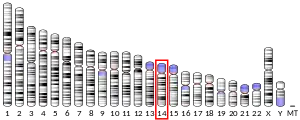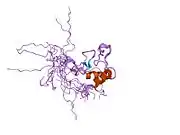| IRF2BPL | |||||||||||||||||||||||||||||||||||||||||||||||||||
|---|---|---|---|---|---|---|---|---|---|---|---|---|---|---|---|---|---|---|---|---|---|---|---|---|---|---|---|---|---|---|---|---|---|---|---|---|---|---|---|---|---|---|---|---|---|---|---|---|---|---|---|
 | |||||||||||||||||||||||||||||||||||||||||||||||||||
| |||||||||||||||||||||||||||||||||||||||||||||||||||
| Identifiers | |||||||||||||||||||||||||||||||||||||||||||||||||||
| Aliases | IRF2BPL, C14orf4, EAP1, interferon regulatory factor 2 binding protein like, enhanced at puberty protein 1, NEDAMSS | ||||||||||||||||||||||||||||||||||||||||||||||||||
| External IDs | OMIM: 611720 MGI: 2442463 HomoloGene: 11555 GeneCards: IRF2BPL | ||||||||||||||||||||||||||||||||||||||||||||||||||
| |||||||||||||||||||||||||||||||||||||||||||||||||||
| |||||||||||||||||||||||||||||||||||||||||||||||||||
| |||||||||||||||||||||||||||||||||||||||||||||||||||
| |||||||||||||||||||||||||||||||||||||||||||||||||||
| Wikidata | |||||||||||||||||||||||||||||||||||||||||||||||||||
| |||||||||||||||||||||||||||||||||||||||||||||||||||
Interferon regulatory factor 2 binding protein like is a protein that in humans is encoded by the IRF2BPL gene.[5][6][7] Mutations are associated with neurological problems.[8] More specifically, mutations of the gene cause the NEDAMSS syndrome, whose abbreviation stands for NEurodevelopmental Disorder with regression, Abnormal Movements, loss of Speech, and Seizures, first described in 2018.
References
- 1 2 3 GRCh38: Ensembl release 89: ENSG00000119669 - Ensembl, May 2017
- 1 2 3 GRCm38: Ensembl release 89: ENSMUSG00000034168 - Ensembl, May 2017
- ↑ "Human PubMed Reference:". National Center for Biotechnology Information, U.S. National Library of Medicine.
- ↑ "Mouse PubMed Reference:". National Center for Biotechnology Information, U.S. National Library of Medicine.
- ↑ Rampazzo A, Pivotto F, Occhi G, Tiso N, Bortoluzzi S, Rowen L, Hood L, Nava A, Danieli GA (Nov 2000). "Characterization of C14orf4, a novel intronless human gene containing a polyglutamine repeat, mapped to the ARVD1 critical region". Biochemical and Biophysical Research Communications. 278 (3): 766–74. doi:10.1006/bbrc.2000.3883. PMID 11095982.
- ↑ Heger S, Mastronardi C, Dissen GA, Lomniczi A, Cabrera R, Roth CL, Jung H, Galimi F, Sippell W, Ojeda SR (Aug 2007). "Enhanced at puberty 1 (EAP1) is a new transcriptional regulator of the female neuroendocrine reproductive axis". The Journal of Clinical Investigation. 117 (8): 2145–54. doi:10.1172/JCI31752. PMC 1906733. PMID 17627301.
- ↑ "IRF2BPL interferon regulatory factor 2 binding protein like [ Homo sapiens (human) ]".
- ↑ Paul C. Marcogliese; et al. (2018). "IRF2BPL Is Associated with Neurological Phenotypes". American Journal of Human Genetics. 103 (2): 245–260. doi:10.1016/j.ajhg.2018.07.006. PMC 6081494. PMID 30057031.
External links
- Human IRF2BPL genome location and IRF2BPL gene details page in the UCSC Genome Browser.
- Parent Group Europe http://irf2bpl.de
Further reading
- Bonaldo MF, Lennon G, Soares MB (Sep 1996). "Normalization and subtraction: two approaches to facilitate gene discovery". Genome Research. 6 (9): 791–806. doi:10.1101/gr.6.9.791. PMID 8889548.
- Nagase T, Nakayama M, Nakajima D, Kikuno R, Ohara O (Apr 2001). "Prediction of the coding sequences of unidentified human genes. XX. The complete sequences of 100 new cDNA clones from brain which code for large proteins in vitro". DNA Research. 8 (2): 85–95. doi:10.1093/dnares/8.2.85. PMID 11347906.
- Scott MP, Zappacosta F, Kim EY, Annan RS, Miller WT (Aug 2002). "Identification of novel SH3 domain ligands for the Src family kinase Hck. Wiskott-Aldrich syndrome protein (WASP), WASP-interacting protein (WIP), and ELMO1". The Journal of Biological Chemistry. 277 (31): 28238–46. doi:10.1074/jbc.M202783200. PMID 12029088.
- Beausoleil SA, Jedrychowski M, Schwartz D, Elias JE, Villén J, Li J, Cohn MA, Cantley LC, Gygi SP (Aug 2004). "Large-scale characterization of HeLa cell nuclear phosphoproteins". Proceedings of the National Academy of Sciences of the United States of America. 101 (33): 12130–5. Bibcode:2004PNAS..10112130B. doi:10.1073/pnas.0404720101. PMC 514446. PMID 15302935.
- Ballif BA, Villén J, Beausoleil SA, Schwartz D, Gygi SP (Nov 2004). "Phosphoproteomic analysis of the developing mouse brain". Molecular & Cellular Proteomics. 3 (11): 1093–101. doi:10.1074/mcp.M400085-MCP200. PMID 15345747.
- Olsen JV, Blagoev B, Gnad F, Macek B, Kumar C, Mortensen P, Mann M (Nov 2006). "Global, in vivo, and site-specific phosphorylation dynamics in signaling networks". Cell. 127 (3): 635–48. doi:10.1016/j.cell.2006.09.026. PMID 17081983.
This article is issued from Wikipedia. The text is licensed under Creative Commons - Attribution - Sharealike. Additional terms may apply for the media files.





